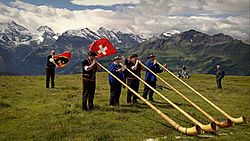Alp horn

Grindelwald Swiss alphorn players
|
The alphorn or alpenhorn or alpine horn is a labrophone, consisting of a wooden natural horn of conical bore, having a wooden cup-shaped mouthpiece, used by mountain dwellers in the Swiss Alps, Austrian Alps, Bavarian Alps in Germany, French Alps, and elsewhere. Similar wooden horns were used for communication in most mountainous regions of Europe, from the Alps to the Carpathians.
For a long time, scholars believed that the alphorn had been derived from the Roman-Etruscan lituus, because of their resemblance in shape, and because of the word liti, meaning Alphorn in the dialect of Obwalden. There is no documented evidence for this theory, however, and, the word liti was probably borrowed from 16th–18th century writings in Latin, where the word lituus could describe various wind instruments, such as the horn, the crumhorn, or the cornett. Swiss naturalist Conrad Gesner used the words lituum alpinum for the first known detailed description of the alphorn in his De raris et admirandis herbis in 1555. The oldest known document using the German word Alphorn is a page from a 1527 account book from the former Cistercian abbey St. Urban near Pfaffnau mentioning the payment of two Batzen for an itinerant alphorn player from the Valais.
17th–19th century collections of alpine myths and legends suggest that alphorn-like instruments had frequently been used as signal instruments in village communities since medieval times or earlier, sometimes substituting for the lack of church bells. Surviving artifacts, dating back to as far as ca. AD 1400, include wooden labrophones in their stretched form, like the alphorn, or coiled versions, such as the "Büchel" and the "Allgäuisches Waldhorn" or "Ackerhorn". The alphorn's exact origins remain indeterminate, and the ubiquity of horn-like signal instruments in valleys throughout Europe may indicate a long history of cross influences regarding their construction and usage.
...
Wikipedia
